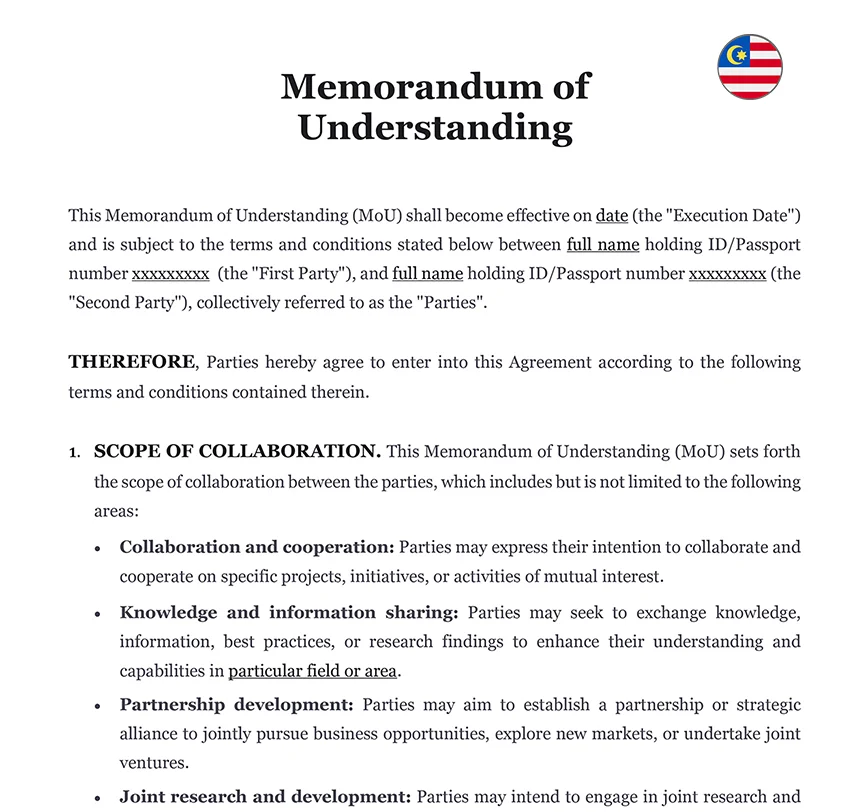Ready to use legal template
Drafted by experienced lawyers
Compliant with Malaysian law
Ready to use legal template
Drafted by lawyers
Compliant with Malaysian law
Home › Business contracts › Memorandum of Understanding
Learn more about Memorandum of Understanding in Malaysia
A Memorandum of Understanding, commonly referred to as an MOU, is a written agreement between two or more parties that outlines their intention to cooperate on a specific project, venture, or goal. It serves as a preliminary document that lays down the terms, conditions, and general framework for the collaboration without creating a legally binding contract. MOUs are often used in various sectors, including business, government, academia, and nonprofit organizations, to establish a mutual understanding and promote cooperation among the involved parties. Themis Partner offers you an easy to edit Memorandum of Understanding drafted by lawyers to comply with the law in Malaysia.
Table of contents
-
What is a Memorandum of Understanding?
-
Why use a Memorandum of Understanding?
-
What should a Memorandum of Understanding include?
-
How does it provide project coordination and goal alignment?
-
How does it help mitigate conflicts and misunderstandings?
-
How does it promote transparency in a partnership?
-
What if I don’t use a Memorandum of Understanding?
What is a Memorandum of Understanding?
A Memorandum of Understanding (MOU) is a written document that outlines the mutual understanding and intentions between two or more parties to collaborate on a particular project, venture, or goal. It serves as a preliminary agreement that establishes a framework for cooperation and sets out the basic terms, conditions, and objectives of the collaboration. While an MOU is not legally binding, it carries significant weight in fostering communication, coordination, and shared understanding among the involved parties. This document is commonly used in various sectors, including business, government, academia, and nonprofit organizations, to initiate partnerships, outline responsibilities, and facilitate smooth collaboration. It provides a flexible and transparent platform for parties to align their goals, establish working relationships, and pave the way for further negotiations and the development of legally binding contracts or agreements.
Why use a Memorandum of Understanding?
A Memorandum of Understanding (MOU) is a valuable tool that serves several purposes when initiating collaborations or partnerships.
| ➤ Firstly, it establishes a common understanding and sets clear expectations between the parties involved, whether they are organizations, individuals, or entities. |
| ➤ Secondly, an MOU provides a flexible framework for outlining the roles, responsibilities, and objectives of each party in a partnership agreement. |
| ➤ It serves as a preliminary document that can be used to align goals, share resources, and define the scope of the collaboration. |
| ➤ Additionally, an MOU can lay the foundation for more formal and legally binding agreements such as a shareholders agreement, which specifically addresses ownership, voting rights, and profit distribution in joint ventures or companies with multiple shareholders. |
ℹ️ Overall, a Memorandum of Understanding helps establish a solid foundation for successful partnerships, mitigates misunderstandings, and allows parties to clarify their commitments and expectations before entering into more detailed agreements.
What should a Memorandum of Understanding include?
1. Introduction and purpose
A brief statement introducing the parties involved, their names, contact information, and a clear identification of their roles or organizations.
A clear and concise description of the purpose and objectives of the collaboration, outlining the specific project, venture, or goal that the MOU is intended to support.
2. Scope
A definition of the scope and boundaries of the collaboration, specifying the activities, tasks, or responsibilities that each party will undertake.
3. Terms and condition
A list of key terms and conditions that govern the collaboration, including the duration of the agreement, termination clauses, confidentiality requirements, Intellectual Property rights, and dispute resolution mechanisms.
4. Roles and Responsibilities
A detailed outline of the roles, responsibilities, and obligations of each party involved, highlighting their contributions, resources, and any specific deliverables they are expected to provide.
5. Resources and Contributions
A section that outlines the resources, funding, personnel, or other contributions that each party will provide to support the collaboration.
6. Communication and Reporting
Guidelines on how communication, information sharing, and reporting will take place among the parties, including frequency, methods, and channels of communication.
7. Review and Amendments
A provision specifying the process for reviewing and updating the MOU, as well as any procedures for making amendments or modifications to the agreement.
8. Signatures
Spaces for the authorised representatives of each party to sign and date the MOU, indicating their agreement and commitment to the terms outlined within.
ℹ️ It’s important to note that the specific contents of an MOU may vary depending on the nature of the collaboration, the parties involved, and the intended outcomes. Therefore, customisation and tailoring of the MOU to suit the specific needs and circumstances of the parties is advisable.
How does it provide project coordination and goal alignment?
A Memorandum of Understanding plays a crucial role in providing project coordination and goal alignment among the parties involved in a collaboration. By clearly defining the scope, objectives, and responsibilities of each party, the MOU serves as a roadmap for the project, guiding the participants towards a shared vision and common goals. It facilitates coordination by outlining the tasks, activities, and timelines that need to be followed, ensuring that all parties are on the same page regarding project milestones and deliverables. Additionally, the MOU promotes goal alignment by establishing a mutual understanding of the desired outcomes and expected results. It allows the parties to align their objectives, identify areas of synergy, and work towards a common purpose. Through this document, the project stakeholders can enhance coordination, streamline efforts, and ensure that everyone is working towards the same set of goals, ultimately increasing the chances of project success.
How does it help mitigate conflicts and misunderstandings?
In Malaysia, a Memorandum of Understanding (MOU) serves as a valuable tool for mitigating conflicts and misunderstandings among parties involved in various collaborations. Malaysia, being a diverse and multicultural country, often sees collaborations between organizations, government bodies, and individuals with different backgrounds, perspectives, and expectations.
| ➤ The MOU helps to establish a common understanding and clear expectations by clearly defining the roles, responsibilities, and objectives of each party. By having these details documented, potential conflicts and misunderstandings can be addressed proactively, preventing disagreements from escalating. |
| ➤ The MOU also allows for open communication and a platform for parties to clarify their intentions, obligations, and desired outcomes, thus reducing the likelihood of misinterpretations or miscommunications. |
| ➤ In addition, the MOU can provide guidelines for dispute resolution mechanisms, facilitating a structured and fair process for resolving conflicts, should they arise. |
ℹ️ Overall, the use of an MOU in Malaysia promotes transparency, clarity, and effective communication, thereby minimising conflicts and fostering successful collaborations.
How does it promote transparency in a partnership?
A Memorandum of Understanding (MOU) plays a crucial role in promoting transparency within a partnership. Transparency is essential for building trust, fostering effective communication, and ensuring accountability among the parties involved. It serves as a written document that clearly outlines the terms, conditions, and expectations of the partnership. By documenting these details, the MOU provides transparency regarding the roles, responsibilities, and obligations of each party. It also defines the scope of the partnership, the resources involved, and any financial or operational considerations. This transparency helps prevent misunderstandings and ensures that all parties have a shared understanding of the collaboration. Moreover, it can include provisions for regular reporting, updates, and review processes, further enhancing transparency by providing opportunities for ongoing communication and evaluation.
ℹ️ Overall, the use of an MOU in a partnership fosters transparency by clearly defining expectations, responsibilities, and communication channels, thereby enabling the parties to work together in an open and transparent manner.
What if I don’t use a Memorandum of Understanding?
If a Memorandum of Understanding (MOU) is not utilised in Malaysia, it can lead to various challenges and potential drawbacks in collaborations.
1. Without an MOU, there may be a lack of clarity and mutual understanding among the parties involved. This can result in misunderstandings regarding roles, responsibilities, and expectations, leading to conflicts and disputes.
2.The absence of a formal agreement can also create ambiguity regarding the scope, duration, and specific terms of the collaboration, potentially affecting the project’s progress and outcomes.
3. Additionally, without an MOU, there may be limited legal protection or recourse for the parties involved in case of breaches or disagreements.This lack of legal enforceability can undermine the trust and confidence between collaborators and hinder effective problem-solving.
Overall, not using an MOU in Malaysia may increase the risk of miscommunication, conflicts, and potential project failures, making it prudent to utilise this document to establish a clear framework and promote a successful collaboration.
SPECIAL OFFER
Startup
15 Document Package
Essential documents for running your business in Malaysia
Memorandum of UnderstandingTemplate (.docx)
Save on attorney fees
310 client reviews (4.8/5) ⭐⭐⭐⭐⭐
Share information
Why Themis Partner ?
Make documents forhundreds of purposes
Hundreds of documents
Instant access to our entire library of documents for Malaysia.
24/7 legal support
Free legal advice from our network of qualified lawyers.
Easily customized
Editable Word documents, unlimited revisions and copies.
Legal and Reliable
Documents written by lawyers that you can use with confidence.




